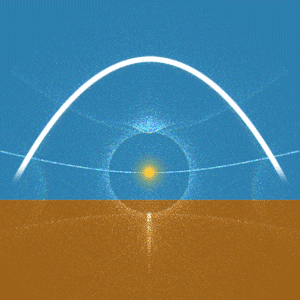The supralateral arc changes its shape with the solar altitude. If the sun is lower than 15°, then the supralateral arc touches the
46° ring at the sides. When the sun is on the horizon, the contact points with the 46° ring are at solar height. At a solar altitude of 15°-27°, the supralateral arc almost coincides with the 46° ring, making it very difficult to distinguish. In fact, many observations of the 46° ring seem to actually be sightings of the supralateral arc. It is only from a solar altitude between 27° and 32° that the supralateral arc is significantly higher than the 46° ring. Moreover, the
circumzenithal arc also provides a clue for differentiation, as the circumzenithal arc touches the supralateral arc at all solar altitudes. However, this also applies to the 46° ring at solar altitudes between 15° and 27°. Another distinguishing feature can be the stronger coloration of the supralateral arc. The 46° ring is usually only white or has a weak reddish inner edge. The supralateral arc, on the other hand, is much more strongly colored. Blue and green are also clearly visible. Its coloration and brightness can match that of the
rainbow.
The supralateral arc forms in
floating column crystals. Light enters through the vertical base and exits through one of the prism surfaces. Since the contact arcs of the 22° halo also form in floating column crystals, the presence of a strongly pronounced
contact arc can indicate that the arc above is the supralateral arc and not the 46° ring.

